Bok choy
Bok choy (American English, Canadian English, and Australian English), pak choi (British English) or pok choi (Brassica rapa subsp. chinensis) is a type of Chinese cabbage, used as food. Chinensis varieties do not form heads and have green leaf blades with lighter bulbous bottoms instead, forming a cluster reminiscent of mustard greens. It has a flavor between spinach and water chestnuts but is slightly sweeter, with a mildly peppery undertone. The green leaves have a stronger flavor than the white bulb.[2][3]
| Bok choy | |
|---|---|
.jpg.webp) Brassica rapa chinensis, called "bok choy" in the United States | |
| Species | Brassica rapa |
| Cultivar group | Chinensis |
| Origin | China, 5th century AD[1] |
Chinensis varieties are popular in southern China, East Asia, and Southeast Asia. Being winter-hardy, they are increasingly grown in Northern Europe. Now considered a subspecies of Brassica rapa, this group was originally classified as its own species under the name Brassica chinensis by Carl Linnaeus. They are a member of the family of Brassicaceae or Cruciferae, also commonly known as the mustards, the crucifers, or the cabbage family.
Spelling and naming variations
| Cooked bok choy | |
|---|---|
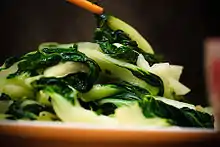 | |
| Chinese name | |
| Chinese | 青菜, 小白菜 |
| Hanyu Pinyin | qīngcài, xiǎobáicài |
| Bopomofo | ㄑㄧㄥ ㄘㄞˋ, ㄒㄧㄠˇ ㄅㄞˊ ㄘㄞˋ |
| Gwoyeu Romatzyh | chingtsay, sheaubairtsay |
| IPA | [tɕʰíŋ.tsʰâɪ], [ɕjàʊ.pǎɪ.tsʰâɪ] |
| Romanization | tsching tsae |
| Cantonese and Southern Min name | |
| Chinese | 白菜 |
| Yale Romanization | baahk choi |
| Jyutping | baak6 coi3 |
| IPA | [pàːk tsʰɔ̄ːy] |
| Hokkien POJ | pe̍h-chhài or pe̍eh-chhài |
| Korean name | |
| Hangul | 청경채 |
| Hanja | 靑莖菜 |
| Revised Romanization | cheonggyeongchae |
| Japanese name | |
| Kanji | 青梗菜 |
| Katakana | チンゲンサイ |
| Romanization | chingensai |
Other than the ambiguous term "Chinese cabbage", the most widely used name in North America for the chinensis variety is simply bok choy (Cantonese for "white vegetable") or siu bok choy (Cantonese, for "small white vegetable"; as opposed to dai bok choy meaning "big white vegetable" which refers to the larger Napa cabbage). It can also be spelled pak choi, bok choi, and pak choy. In the UK and South Africa, the term pak choi is used. Less commonly, the descriptive English names Chinese chard, Chinese mustard, celery mustard, and spoon cabbage are also employed.
In Australia, the New South Wales Department of Primary Industries has redefined many transcribed names to refer to specific cultivars. In addition, they have introduced the word buk choy to refer to a specific kind of cabbage distinct from pak choy.[4][5]
In Mandarin Chinese, the common name is 青菜 qing cai ("green vegetable")[6] or 小白菜 xiao bai cai ("small white vegetable"). Although it is simply called 白菜 baak choi ("white vegetable") in Cantonese, the same characters pronounced bai cai by Mandarin speakers are preferably used as the name for Napa cabbage.[7]
What is labelled Bok Choy may come in 2 forms: white bok choy (Chinese: 奶白菜; lit. 'milky white vegetable',[8] or in Cantonese simply Chinese: 白菜; lit. 'white vegetable') or Shanghai bok choy (Chinese: 上海青; lit. 'Shanghai green', Chinese: 青江菜; lit. 'green river vegetable', or Chinese: 小棠菜 siu tong choy). White bok choy is usually more expensive and has dark-colored crinkly leaves and stem portions that are white and a crisp texture that is more suitable for Cantonese-style cooking, stir-fries, and simple or raw preparations.[9] Shanghai bok choy has greater availability in most American markets, and has mild-tasting spoon-shaped leaves that are lighter green with stems that are jade green instead of white. The texture of Shanghai bok choy is less crisp, and it gets slimy if overcooked but otherwise can often be substituted for white bok choy.[10]
Uses
Cooking
Bok choi cooks in 2 to 3 minutes by steaming, stir-frying, or simmering in water (8 minutes if steamed whole). The leaves cook more quickly than the stem. It is used in similar ways to other leafy vegetables such as spinach and cabbage.[11] It can also be eaten raw.[12] They are commonly used in salads.
Nutritional value
| Nutritional value per 100 g (3.5 oz) | |
|---|---|
| Energy | 54 kJ (13 kcal) |
2.2 g | |
| Dietary fiber | 1.0 g |
0.2 g | |
1.5 g | |
| Vitamins | Quantity %DV† |
| Vitamin A equiv. | 30% 243 μg25% 2681 μg |
| Thiamine (B1) | 3% 0.04 mg |
| Riboflavin (B2) | 6% 0.07 mg |
| Niacin (B3) | 3% 0.5 mg |
| Pantothenic acid (B5) | 2% 0.09 mg |
| Vitamin B6 | 15% 0.19 mg |
| Folate (B9) | 17% 66 μg |
| Vitamin C | 54% 45 mg |
| Vitamin K | 44% 46 μg |
| Minerals | Quantity %DV† |
| Calcium | 11% 105 mg |
| Iron | 6% 0.80 mg |
| Magnesium | 5% 19 mg |
| Manganese | 8% 0.16 mg |
| Potassium | 5% 252 mg |
| Sodium | 4% 65 mg |
| Other constituents | Quantity |
| Water | 95.3 g |
| |
| †Percentages are roughly approximated using US recommendations for adults. | |
See the table for the nutritional content of bok choy. The raw vegetable is 95% water, 2% carbohydrates, 1% protein and less than 1% fat. In a 100-gram (3+1⁄2-ounce) reference serving, raw bok choy provides 54 kilojoules (13 food calories) of food energy and is a rich source (20% or more of the Daily Value, DV) of vitamin A (30% DV), vitamin C (54% DV) and vitamin K (44% DV), while providing folate, vitamin B6 and calcium in moderate amounts (10–17% DV).
History
Bok choy evolved in China, where it has been cultivated since the 5th century AD.[1]
Gallery
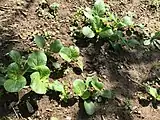 Young bok choy plants in garden
Young bok choy plants in garden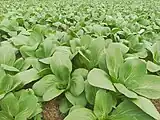 Bok choy
Bok choy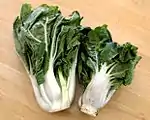 White bok choy
White bok choy.JPG.webp) Shanghai bok choy
Shanghai bok choy Bok choy plant in side view
Bok choy plant in side view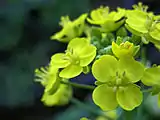 Bok choy has yellow flowers
Bok choy has yellow flowers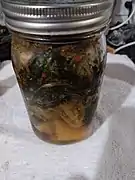 Homemade kimchi made from bok choy
Homemade kimchi made from bok choy
References
- Sanderson, Helen; Renfrew, Jane M. (2005). Prance, Ghillean; Nesbitt, Mark (eds.). The Cultural History of Plants. Routledge. p. 115. ISBN 0415927463.
- "What Does Pak Choi Taste Like?". Thrive Cuisine. 2 March 2019. Retrieved 13 December 2021.
- "Genetic Characterization of Brassica rapa chinensis L.,B. rapa parachinensis (L. H. Bailey) Hanelt, and B. oleracea alboglabra (L. H. Bailey) Hanelt Using Simple Sequence Repeat Markers" (PDF). Philippine Journal of Science. December 2009. Retrieved 16 February 2023.
- "Help is on the way for consumers confused by the wide array of Asian vegetables on sale". 2009-10-22. Archived from the original on 2007-08-20. Retrieved 2011-09-08.
- "Asian vegetable names" (PDF). Archived (PDF) from the original on 2006-10-30.
- "Brassica rapa var. chinensis in Flora of China". efloras.org. Retrieved 2022-04-28.
- "Brassica rapa var. glabra in Flora of China". efloras.org. Retrieved 2022-04-28.
- 饶璐璐 (1999). "含微量元素硒的奶白菜". 中国食品 (17) – via 知网.
- "Ingredient Spotlight: Shanghai Bok Choy". 5 October 2011.
- "Regular vs. Shanghai Baby Bok Choy | Cook's Illustrated".
- "Pak choi". BBC Good Food. Retrieved 2 February 2022.
- "Can You Eat Bok Choy Raw". Leftover Guide. Retrieved 7 August 2023.
- "Bok Choy (Dried)". The Chinese Soup Lady. Retrieved 20 February 2023.
- FullHappyBelly. "When my mom visits my backyard garden and sees big bok choy". youtube. Retrieved 20 February 2023.
- "6 Ways to Store Bok Choy so It Lasts Longer". Homestratosphere. 20 May 2019. Retrieved 20 February 2023.
- "Harvesting Bok Choy Plants: How And When To Pick Bok Choy". Gardening Know How. Retrieved 20 February 2023.
External links
 Media related to Brassica rapa subsp. chinensis at Wikimedia Commons
Media related to Brassica rapa subsp. chinensis at Wikimedia Commons Bok Choy at the Wikibooks Cookbook subproject
Bok Choy at the Wikibooks Cookbook subproject